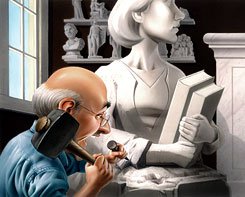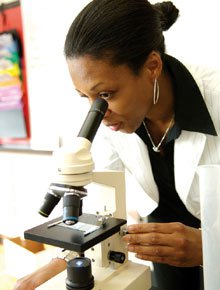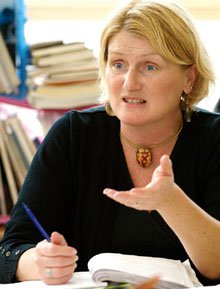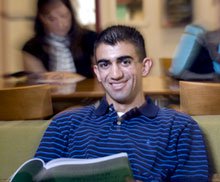Confronting the Crisis in Teacher Training
Innovative schools of education invent better ways to prep educators for the classroom.

Melissa Zipper needs less than a second to tally the value of her teacher-preparation experience: "Nothing."
Looking back on the nine-month master's degree program, she elaborates, "I was reading about all these theories and creating hypothetical lessons and seating charts, but they had no real-world application. Every class I had was based on this utopian group of kids who all spoke English and functioned at the same level. I never learned how to modify or accommodate the diverse needs that I would find in my room."
Unprepared, Zipper began her first day as an intern sixth-grade teacher in a high-poverty neighborhood in East Palo Alto, California, fully responsible, with next to no support from her university. Sound scary? This is scarier: Zipper's alma mater (which she requested not be identified) is one of the largest producers of teachers in California, credentialing about 2,700 people a year.
Cut to Boston, where Maria Fenwick spent a full year working alongside a mentor teacher through the district-sponsored Boston Teacher Residency. By the time she became a full-fledged fourth-grade teacher, she knew the local curriculum, the community, and the daily demands of education, and she was hungry for her own classroom. She recalls, "I knew what to expect every step of the way."
The crisis confronting teacher education is that, across the country, Fenwick's experience is the exception and Zipper's is the rule. Though there are some leading lights, far too many of America's 1,200-plus schools of education are mired in methods that isolate education from the arts and sciences, segregate the theory and practice of teaching, and provide insufficient time and support for future teachers to learn to work in real classrooms. Far too many universities, for their part, run education programs on the cheap.
The consequences are painfully clear: Half of all new educators abandon the profession within five years, costing schools an estimated $2.6 billion annually and leaving children in the neediest areas with the highest number of inexperienced teachers.
The delinquency in teacher preparation is nothing new, of course -- but it's growing more dire as we ask teachers to perform increasingly challenging tasks: to teach more complex skills to high and measurable standards, and to ensure that every child in an incredibly diverse generation learns these skills equally well. The three R's are not enough anymore.
Based on scientific research, good teaching is one thing we know makes a big difference in children's learning. (Researchers at the University of Tennessee in 1996 found that elementary school students who had three highly effective teachers in a row achieved math scores more than fifty percentile points higher than those who had three ineffective teachers in a row.) The challenge now is to figure out how to make a good teacher -- or, as Thomas Carroll, president of the National Commission on Teaching and America's Future (NCTAF), puts it, "to close the gap between the way we prepare teachers and the way teachers actually teach in the classroom."

Dozens of education schools -- and a few independent agencies, such as the Boston Public Schools -- are pioneering ways to do that. The research on how well these new methods work ranges from nascent to nonexistent so far, but these early models provide a compass for how to begin building better programs -- changes that hold the promise to better equip would-be teachers and, by extension, their future students for success.
Devil's Bargain
So-called normal schools, the precursors to today's schools of education, emerged in the mid-1800s to staff a growing number of classrooms, reports Stanford University historian David Labaree. To meet demands for more accessible higher education, they evolved into four-year teachers' colleges and then state colleges and universities by about 1960. In the late 1900s, some universities that didn't have colleges of education grew them.
From the outset, teacher-training programs faced what Labaree calls a "devil's bargain" between quantity and quality: producing enough teachers to meet demand, or preparing fewer teachers to high standards. Under pressure, he says, they chose quantity.
The sheer numbers of education students (who earn more than 7 percent of the bachelor's degrees and 29 percent of the master's degrees granted nationwide), combined with a focus "more on adequacy than on quality," Labaree says, turned education schools into moneymakers for many universities. "The ed school is the Rodney Dangerfield of higher education," he adds. "It don't get no respect."
No respect doesn't mean no expectations, however, especially not in the past fifteen years or so. A cry for better education programs is rising as the scrutiny on K-12 schools' performance under the No Child Left Behind Act flows upstream to the institutions that prepare teachers. Calls for change have come from both outside and inside teacher education. Add to that the growing competition from alternative certification pathways and homegrown programs like Boston's -- such avenues produced about 41,000 of the 220,000 graduates of teacher-preparation programs in 2004 -- and education schools are feeling the pressure.
"Criticisms of the teacher-education establishment have been so incessant and persistent that the work of that establishment is changing," says Suzanne Wilson, chairwoman of the Department of Teacher Education at Michigan State University's College of Education. "People are not ignoring the critiques anymore."
Prep Gets Real
At the heart of reform in teacher preparation are innovations that provide extensive field experience and link theory more closely with practice.

Programs such as Boston's go the furthest by transporting the locus of training almost entirely from the university to the K-12 school. Through the four-year-old residency, supported jointly by the school district and local philanthropies, candidates take summer courses geared toward Boston's history and curriculum, then undergo a yearlong mentorship. The financial package -- an $11,000 stipend plus a forgivable tuition loan -- is designed to attract educators from diverse backgrounds. (Melissa Zipper, who survived her first year with help from an outside mentoring program and is still a teacher, had to shell out $19,000 for her degree.)
In between the stale old university methods and the urban teaching residencies is a practical and promising model that's gaining in reach: the professional-development school. As described by the National Council for the Accreditation of Teacher Education (NCATE), these programs are partnerships between teacher-preparation programs and K-12 schools that provide settings for student teaching, faculty development, and field-based research -- unions so intimate that they form a hybrid institution. A typical field placement in these school-university teams -- which, as does the Boston program, liken themselves to medical residencies in teaching hospitals -- lasts a semester or two.
Kansas's Emporia State University was an early adopter of the model. Its Teachers College provides training and ongoing support to mentor educators in its thirty-four professional-development schools. In turn, mentors commit to give student teachers weekly evaluations and opportunities to do everything from individual tutoring to whole-class teaching. University staff visit classrooms regularly to assess candidates' progress and provide feedback. All the while, the educators-in-training reconvene in university classes to debrief and draw connections to theories of education.
"The key to the success of these programs is that no matter what theory students are learning about, they get to see it in practice immediately," says Dean Tes Mehring.
The payoff: The attrition rate of ESU graduates from teaching is a low 7.2 percent after three years, and principals rate alumni highly on a wide range of knowledge and skills.
Measure This
Besides the theory-practice bond, assessment -- the watchword in K-12 schools -- is catching on in teacher preparation. Education schools at the forefront of this change are creating and using various assessments to measure candidates' skills and identify and improve weaknesses in their programs. ESU, for instance, evaluates candidates via tests, observations, and performance tasks at regular intervals; those who perform below par -- about 4 to 5 percent of students per semester -- get dropped from the teaching program.

It may sound odd in this assessment-happy age, but no, education schools have not always done this. Some impetus for change comes from the NCATE, which accredits 632 of the nation's education schools. In 2001, the organization reinvented its standards to demand more evidence of program outcomes ("what candidates know and can do"), not simply inputs such as coursework and field experience.
Two teams of universities have created teaching-performance assessments that could be used more broadly. The Performance Assessment for California Teachers (PACT), developed by thirty public and private universities, embeds various assessments in candidates' coursework and demands a capstone documentation of three to five teaching hours, including lesson plans, videotapes, and student work. Teacher Work Samples, an assessment methodology adopted by eleven schools nationwide in a coalition called the Renaissance Group, use detailed standards and a rubric to evaluate how well candidates teach a four-week unit.
Raymond Pecheone, co-executive director of Stanford University's School Redesign Network and PACT's project director, draws this analogy: "Back in the early '90s, we used to evaluate people's writing by giving them a multiple-choice exam. This is not rocket science, but if you want to test how well people write, you've got to ask them to write. These tests are sorely needed."
Two even more neglected but emerging education-school adaptations are training in how to use technology for learning, and induction support for beginning teachers after graduation.
Road Not Traveled
One problem in the quest for quality is that accountability measures so far have been mainly quantitative, not qualitative. The federal government, via NCLB, demands that, to be "highly qualified," teachers possess expertise in their subject matter and certification from their state. This requirement assumes that certification ensures skill. In reality, states generally focus more on the number and type of candidates' training experiences than the quality.
A state might require 300 hours of student teaching for licensure, for instance, but "rotten schools of education can place bad students in failing K-12 schools with weak teachers" and still meet the requirement, says Arthur Levine, former president of Columbia University's Teachers College and author of the 2006 report "Educating School Teachers."
Further obscuring the best practices, hardly any education schools have ever followed up with alumni to measure their effectiveness on the job -- until now.
"Historically, a school of education could claim to be strong and be recognized around the country with no evidence about how its teachers perform in the classroom," says the NCTAF's Thomas Carroll. "That day is over."
Early efforts at this kind of accountability have used simple surveys -- not the most rigorous form of research, but they're a start.
Another problem: There is little scientific evidence to guide the way. The small pool of research on what works in teacher preparation generally lacks rigor, and it dates to the days before many of these reforms came about. Education researchers have taken notice of the vacuum and have begun working to fill it, but evidence will take years to build.
More challenges lie ahead. To fully commit to a model of professional-development schools, for one, requires money. Emporia State University's Teachers College has managed it through permanent state allocations and strong commitment by the university, as well as by holding vacant some faculty positions and asking students to pay half of their mentor teachers' $500 annual stipends.
Marshall "Mike" Smith, education-program director at the William and Flora Hewlett Foundation and a former education official in the Clinton and Carter administrations, says broad reform will come only if states revise their standards to demand more field experience with good supervision. According to data compiled by the Education Commission of the States, minimum requirements for student teaching now range from 180 hours in Louisiana to 100 days in Maryland. (The most common figure is about twelve weeks.)
States also must commit more money to preparation programs, Smith says, and teachers themselves must demand better training. What could incite that kind of demand? "Evidence that something else worked clearly better," he responds, "which we don't have."
The need is urgent; teachers work at the frontier of everything education is meant to do. Public education itself grapples intimately with big changes in America, from new languages to health epidemics to economic imperatives. Our answer to the challenge of improving teachers' training will influence the experience children have in classrooms -- and the skills with which children enter adult life -- for years to come. It's a question of what kind of future we want to create.